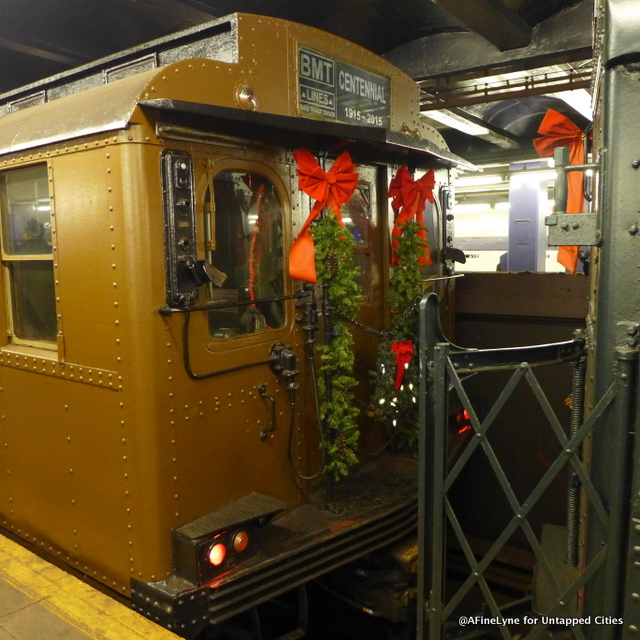
For many, the New York Transit Museum‘s Holiday Nostalgia Rides may be just the ticket that makes the holidays the most wonderful time of year. The fleet of vintage New York City subway cars from the 1930s has been running every Sunday in December, with the last opportunity this year on December 27th. The New York Transit Museum has eight of the IND line R1/9 cars, dubbed the “Shoppers Special,” running along the 6th Avenue line during this years annual Nostalgia Ride, as well as a newly renovated 1928 BMT D-Type Triplex car that is stationed as a pop-up shop at the Second Avenue station.
 One of the cars is a Transit Museum Pop-Up Shop
One of the cars is a Transit Museum Pop-Up Shop
The BMT D-Type Triplex cars were ordered first in 1924, as part of the transition from wooden cars to steel for improved safety. The famous Malbone Street wreck in Brooklyn in 1918 was one of the deadliest train crashes in the United States with 98 deaths. As the Transit Museum elaborates, “Unlike its predecessor, the BRT Standard, the D-Type Triplex featured a three-car articulated unit with shared trucks, allowing passengers to walk from one car to another through an enclosed passageway.The Triplex represented the height of transit modernity with soundproofing, illuminated signs displaying route destinations, and rattan seating.” Each triplex is 137 feet long and can seat 160 passengers.
 Rattan seats, ceiling fans and even a vintage scale
Rattan seats, ceiling fans and even a vintage scale
The R1/9 cars, made for the IND line in the 1930s, were the first subway cars to be identified to contract numbers. Known as “City-Cars,” the R1/9 is considered the “first modern subway car” and a model for subsequent lines. Joe Leader, former Senior Vice President of Subways at the MTA says, “Today’s subway fleets owe a lot to the design. They were basic, durable and offered the expected levels of customer comfort for decades after they were introduced into service. We continue to build upon this strong foundation with each new car design.”

The City-Cars came with Rattan seats (like the BMT triplex), ceiling fans, incandescent light bulbs, and roll signs for passenger information. The design included not only wider doors but also more of them (with faster opening time too) and increased standing capacity. The trains were retired in 1977.

 Stepping on the connector between two of the subway cars
Stepping on the connector between two of the subway cars
In the 1950s, new floors and red cushion seats were added to some of the subway cars. Old-time advertisements for companies and getaway locales like Rockaway Playland, Clark Bars, Levy’s Rye Bread, Aqueduct Raceway, and even Airmail Postal Cards lined the top section of the cars on both sides.





Check out New York City’s abandoned subway stations and the system’s beautiful subway entrances. For a dose of nostalgia, check out the history of NYC’s subway tokens. Get in touch with the author at AFineLyne.





